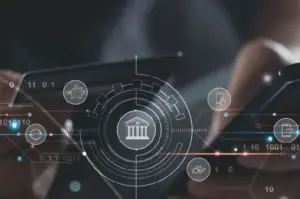Introduction to Facial Recognition Technology
Although people have traditionally used their faces to convey identity and emotion, facial recognition technology has made it feasible to utilize these facial expressions to monitor a person’s activities and even authenticate their real identity. Facial recognition technologies are revolutionizing human identity and verification. Facial recognition technology is a type of biometric software that identifies or verifies a person by analyzing and comparing patterns based on their facial features. It can compare an individual’s face from a digital image or video pixel to an identity saved in a database of faces. It analyzes an individual’s face using algorithms, which enables it to recognize and relate the distinctive traits and dimensions of that person’s distinct identity.
Facial recognition technology has advanced significantly in recent years, improving both its reliability and methods for resolving issues related to security and privacy. It has become ingrained in everyday life and is currently utilized in a wide range of sectors, including retail, law enforcement, immigration, and smartphone technology.
How Facial Recognition Technology Works
- Face Detection: The system detects and locates the face in an image or video
- Face Analysis: It captures and analyzes facial features, such as the distance between the eyes, the shape of the cheekbones, and the contour of the lips
- Image to Data Conversion: The facial features are converted into a mathematical representation called a faceprint
- Matching: The faceprint is compared against a database of known faces to find a match
Facial recognition is widely used in various applications, including security, law enforcement, and unlocking personal devices. However, it has also raised privacy concerns and ethical debates.
Key Real-World Applications of Facial Recognition Technology in Industry
Employee Attendance Management
A growing number of businesses are choosing to switch from touch-based biometric attendance systems to facial recognition time and attendance systems due to the ongoing spread of new diseases, such as COVID-19 in the past few years. Advanced technology solutions like facial recognition automate the process of tracking employee attendance. It ensures accuracy by eliminating the possibility of proxy attendance (where one person clocks in for another) and provides a contactless method, which is especially useful in maintaining hygiene.
Real-world Example: Vodafone uses facial recognition to streamline employee attendance and improve efficiency.
Law Enforcement And Crime Prevention
Facial recognition is used by law enforcement agencies to identify suspects, monitor public spaces, and solve crimes. It can quickly match faces from CCTV footage or other sources against a database of known individuals, helping identify and apprehend suspects more efficiently. Law enforcement organizations can receive fast notifications when a suspected criminal is captured on camera, such as when they visit a retail place, by accessing databases that store the facial prints of previously identified suspects.
Real-world Example: South Wales Police utilizes Automated Facial Recognition (AFR) to identify suspects and persons of interest.
Access Control
In access control systems, facial recognition is used to grant or deny entry to secure areas. This technology enhances security by ensuring that only authorized individuals can access certain locations, reducing the risk of unauthorized entry. Lifts, digital locks, and door access devices are among the obvious uses.
Real-world Example: Amazon implements facial recognition technology for access control in its data centers.
Social Media Profile Verification
Social media platforms use facial recognition to verify user identities, making it easier to tag friends in photos and enhance account security. This technology helps profile authentication by preventing fake profiles, unauthorized access to accounts, online fraud, email spam, and cyberbullying. Facial recognition and other related advanced machine-learning techniques have made profile authentication a fast and reliable procedure that assists in filtering out frauds and fakes.
Real-world Example: Google Photos employs facial recognition to organize and tag photos based on detected faces.
Fintech Operations
In the fintech sector, facial recognition is used for secure customer authentication, preventing fraud, and streamlining processes like loan approvals and account access. It adds an extra layer of security to financial transactions and services. Using facial biometrics to make transactions and payments reduces the possibility of identity theft. Stronger fraud and identity theft prevention, quick and easy identification verification, and safe transactions are all provided by this technology.
Real-world Example: Ant Financial (Alipay) uses facial recognition for secure payments and fraud prevention.
Hospital Management
Facial recognition technology in hospitals helps with patient identification, streamlining check-in processes, and enhancing security. It can also be used to monitor patient conditions and manage access to sensitive areas within the hospital. Facial recognition technology can help track down and recognize a patient who has wandered out from a healthcare facility without identification in a hurry, protecting them from potential danger.
Real-world Example: Martin Luther King Jr. Community Hospital uses facial recognition to enhance security and streamline patient management.
Smart Retailing
Retail shops utilize facial recognition technology for three different reasons: targeted marketing, enhanced service to customers, and payments. In retail, facial recognition is used to enhance customer experiences by personalizing services and offers. It also helps in loss prevention by identifying known shoplifters and improving store security. Additionally, it can be used for contactless payments and gathering customer analytics.
Real-world Example: Rite Aid has implemented facial recognition in stores to deter theft and improve safety.
Benefits and Challenges
Benefits of Facial Recognition Technology
Benefits of Facial Recognition Technology
- IMPROVED SAFETY AND SECURITY
- FAST PROCESSING NATURE
- ENHANCED ACCURACY
- MINIMAL HUMAN TOUCHPOINTS
- EASY INTEGRATION
Improved Safety and Security
High speed, precision, and dependability are already well-known features of facial recognition technology. Facial recognition also enhances security by accurately identifying individuals based on unique facial features. It is used in various settings, from airports to public events, to quickly identify and prevent potential threats. This technology also helps in crime prevention and law enforcement by matching faces against criminal databases.
Fast Processing Nature
Presenting identification cards, remembering passwords, and other hassles are part of existing identity verification techniques. Owever, facial recognition systems process and interpret data quickly and do not require human interaction, making them ideal for applications that require rapid identification, such as airport security checks or unlocking devices. Businesses can regulate access to places with minimal wait times by utilizing facial recognition technology, which improves overall efficiency.
Enhanced Accuracy
Modern facial recognition systems boast high accuracy rates, thanks to advanced algorithms and machine learning. This accuracy minimizes the risk of misidentification and ensures reliable verification, which is crucial for security and authentication purposes. Facial recognition is a great solution for businesses that want to swiftly clock employees in or limit access to specific facilities to authorized employees only.
Minimal Human Touchpoints
Facial recognition technology requires minimal physical contact, making it a hygienic option, especially in the post-pandemic world. It reduces the need for manual checks and interactions, streamlining processes like attendance tracking and access control. Furthermore, facial recognition technology demands fewer human resources than other security methods like fingerprint recognition.
Easy Integration
Facial recognition systems can be easily integrated with existing security and IT infrastructure. This flexibility allows organizations to adopt the technology without significant upfront investments, making it accessible and cost-effective. Smartphones with frontal cameras, for instance, include built-in capability for facial recognition models or programs. Face recognition is especially crucial for rapid and effective processing because it does not require an internet connection.
Challenges in Facial Recognition Technology
Facial recognition technology, while powerful, faces several challenges. Addressing these challenges requires ongoing advancements in technology, robust security measures, ethical considerations, and clear regulatory frameworks.
| Challenge | Issues Involved | |
| Issues Related to Lighting and Occlusions | Lighting and Pose Variations: Changes in lighting and different facial angles can affect the accuracy of facial recognition systems. | Occlusions: Items like glasses, masks, or hats can obscure facial features, making it harder for the system to identify individuals correctly. |
| Spoofing and Data Breach Concerns | Spoofing: Facial recognition systems can be tricked by photos, videos, or even 3D masks, posing a significant security risk. | Data Breaches: Storing facial data poses a risk of data breaches, which can lead to identity theft and other security issues. |
| Ethical and Privacy Issues | Surveillance: The use of facial recognition for mass surveillance raises significant privacy concerns and can lead to a loss of anonymity in public spaces. | Bias and Discrimination: Facial recognition systems can exhibit biases, particularly against certain racial and ethnic groups, leading to unfair treatment and wrongful identifications. |
| Deployment Challenges | Integration: Integrating facial recognition technology with existing systems can be complex and costly. | Regulatory Compliance: Navigating the legal landscape, which varies by region, can be challenging for organizations looking to implement facial recognition technology. |
Ready to take your business to the next level with innovative, data-driven strategies? Let’s collaborate and create unparalleled success together with Infiniti Research…
Legal and Ethical Considerations
Facial recognition technology presents several legal and ethical challenges:
Legal Issues
- Privacy Concerns: The use of facial recognition can infringe on individual privacy rights, especially when used without consent. This is a significant concern in public surveillance.
- Data Protection: Storing and processing biometric data involves stringent data protection laws. Non-compliance with regulations like GDPR in Europe can lead to severe penalties.
- Informed Consent: Legal frameworks often require that individuals be informed and give consent before their biometric data is collected and used.
- Regulatory Compliance: Different regions have varying laws regarding the use of facial recognition, making it challenging for organizations to ensure compliance across jurisdictions.
Ethical Issues
- Bias and Discrimination: Facial recognition systems can exhibit biases, particularly against certain racial and ethnic groups, leading to unfair treatment and wrongful identifications.
- Mass Surveillance: The potential for mass surveillance raises ethical concerns about the loss of anonymity and the potential misuse of this technology by governments and corporations.
- Lack of Transparency: There is often a lack of transparency about how facial recognition data is collected, stored, and used, which can erode public trust.
- Misuse of Data: The potential for misuse of biometric data, such as unauthorized sharing or selling of data, poses significant ethical concerns.
Addressing these issues requires robust legal frameworks, ethical guidelines, and ongoing oversight to ensure that the technology is used responsibly and fairly.
Future Outlook and Trends
The future of facial recognition technology is promising, with several key trends and advancements on the horizon:
-
Enhanced AI Capabilities
Artificial Intelligence (AI) will continue to improve the accuracy and efficiency of facial recognition systems. AI-driven algorithms will enhance the ability to recognize faces in various conditions, such as different lighting, angles, and occlusions.
-
3D & Multi-Modal Recognition
The integration of 3D facial recognition and multi-modal biometric systems (combining facial recognition with other biometric methods like fingerprint or iris scanning) will increase robustness and accuracy. 3D recognition is less affected by changes in lighting and facial expressions.
-
Privacy & Ethical Considerations
There will be a stronger focus on addressing privacy and ethical issues. This includes developing technologies that ensure data protection and compliance with regulations, as well as creating transparent and fair systems to mitigate biases.
-
Wider Adoption in Various Sectors
Facial recognition will see broader adoption across different industries, including healthcare, retail, finance, and security. For example, in healthcare, it can streamline patient identification and enhance security in medical facilities.
-
Improved Real-World Application
Future developments will focus on making facial recognition more robust in real-world scenarios. This includes improving performance in diverse environments and ensuring the technology can handle large-scale deployments.
-
Integration with IoT and Smart Devices
Facial recognition will increasingly be integrated with Internet of Things (IoT) devices and smart home systems, providing seamless and secure user experiences. This trend will enhance the convenience and security of smart devices.
-
Standardization and Regulation
As facial recognition technology matures, there will be a push toward establishing industry standards and regulations to ensure consistent and ethical use of facial recognition. This will help build public trust and facilitate wider adoption.
Case Study
| Case Study: How a major airline in the U.S., headquartered in Atlanta, Georgia, overcame challenges with long wait times and inefficiencies using facial recognition technology. |
| Background: A major airline in the US headquartered in Atlanta, Georgia, faced challenges with long wait times and inefficiencies during the boarding process. Traditional methods of checking IDs and boarding passes were time-consuming and often led to bottlenecks, especially during peak travel times. Solution: To address these issues, the airline implemented facial recognition technology at several key airports, including Atlanta’s Hartsfield-Jackson International Airport. The technology was integrated into various stages of the passenger journey, from check-in to boarding. Implementation Steps: Check-In: Passengers can opt-in to use facial recognition by linking their passport photos to their boarding passes. At the check-in kiosks, cameras capture the passenger’s face and match it with the stored image. Bag Drop: At the bag drop counters, passengers’ faces are scanned to verify their identity, eliminating the need to show a boarding pass or ID. Security Check: Facial recognition is used at TSA checkpoints to streamline the security process. Passengers’ faces are matched with their travel documents, speeding up the verification process. Boarding: At the boarding gate, passengers simply look into a camera, and their faces are matched with the database. This allows them to board the plane without needing to present a boarding pass. Results: Reduced Wait Times: The implementation of facial recognition technology significantly reduced wait times at various checkpoints. Passengers experienced a smoother and faster boarding process. Improved Passenger Experience: The contactless nature of the technology enhanced the overall passenger experience, making travel more convenient and efficient. Operational Efficiency: The airline was able to streamline operations, reduce the workload on staff, and improve overall efficiency at the airport. Privacy and Security Measures: Opt-In System: Participation in the facial recognition program is voluntary. Passengers can choose whether or not to use the technology. Data Protection: The airline ensures that all biometric data is securely stored and complies with data protection regulations. The data is used solely for the purpose of identity verification and is not shared with third parties. |
| This case study highlights how the airline successfully addressed the challenges of long wait times and inefficiencies, providing a more seamless and enjoyable travel experience for its passengers. |
Conclusion
In short, facial recognition technology has brought about unparalleled changes in the business arena. In addition, new technological advancements and the widespread applications of facial recognition technology allow users to access critical services more quickly, easily, and dependably.
Businesses are utilizing its advantages, including enhanced security options, contactless verification features, faster procedures for increased productivity, and customization choices that satisfy users’ utility requirements, far more than ever. Given all of these advantages, it is not surprising that applications of facial recognition technology are expanding continuously.
Unlock the power of cutting-edge solutions designed to drive growth, enhance efficiency, and transform your business outcomes—partner with Infiniti Research today…



